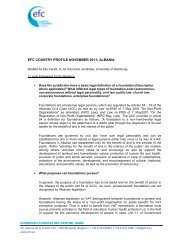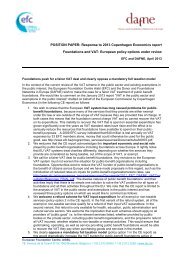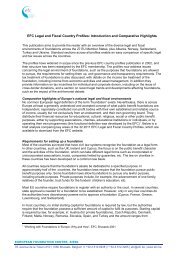European perspectives on global health: a policy glossary
European perspectives on global health: a policy glossary
European perspectives on global health: a policy glossary
You also want an ePaper? Increase the reach of your titles
YUMPU automatically turns print PDFs into web optimized ePapers that Google loves.
4. Europe must establish a societal dialogue for <strong>global</strong> <strong>health</strong><br />
Public-private partnership<br />
Public-Private Partnerships ( PPPs ) are hybrid forms<br />
of regulati<strong>on</strong> between state and n<strong>on</strong>-state actors<br />
and can broadly be defined as “collaborative<br />
relati<strong>on</strong>ship am<strong>on</strong>g multiple organisati<strong>on</strong>s in which<br />
risks and benefits are shared in pursuit of a shared<br />
goal” ( Carls<strong>on</strong> 2004 ).<br />
In the <strong>health</strong> sector Public-Private Partnerships play<br />
a role especially in three c<strong>on</strong>texts : in the provisi<strong>on</strong><br />
of <strong>health</strong>-related services in the <str<strong>on</strong>g>European</str<strong>on</strong>g> countries<br />
themselves, as a mechanism of development<br />
cooperati<strong>on</strong> in bilateral relati<strong>on</strong>ships, and as a<br />
<strong>global</strong> means to tackle <strong>health</strong>-related problems that<br />
transcend nati<strong>on</strong>al boundaries.<br />
PPPs c<strong>on</strong>sist of two basic types of actors – State and<br />
n<strong>on</strong>-State actors – that can be further differentiated<br />
by their level of activity and their respective sector.<br />
The main State actors represented in Global Public-<br />
Private Partnerships ( GPPPs ) come from the nati<strong>on</strong>al<br />
level ( governments, bilateral agencies ), the local level<br />
( administrative bodies, local governments ) and the<br />
internati<strong>on</strong>al level ( internati<strong>on</strong>al organisati<strong>on</strong>s ). The<br />
n<strong>on</strong>-state actors can be further divided into those<br />
from the private sector ( for-profit companies, business<br />
associati<strong>on</strong>s, foundati<strong>on</strong>s ) and those from the civil<br />
society sector ( grass-roots organisati<strong>on</strong>s, nati<strong>on</strong>al<br />
NGOs, internati<strong>on</strong>al NGOs ).<br />
In <strong>global</strong> <strong>health</strong> PPPs started to gain importance<br />
in the beginning of the 1990s. In a phase where<br />
the UN system was increasingly criticised for being<br />
bureaucratic and ineffective and where nati<strong>on</strong> states<br />
where losing regulating authority due to <strong>global</strong>isati<strong>on</strong><br />
processes, cooperati<strong>on</strong> with n<strong>on</strong>-state actors in the<br />
form of GPPPs seemed a promising way forward in<br />
order to address issues that could not be solved in the<br />
nati<strong>on</strong>al c<strong>on</strong>text or by single actors al<strong>on</strong>e. This specific<br />
type of partnership can be defined as : “collaborative<br />
relati<strong>on</strong>ship which transcends nati<strong>on</strong>al boundaries<br />
and brings together at least three parties, am<strong>on</strong>g<br />
them a corporati<strong>on</strong> ( and / or industry associati<strong>on</strong> ) and<br />
an intergovernmental organisati<strong>on</strong>, so as to achieve a<br />
shared <strong>health</strong>-creating goal <strong>on</strong> the basis of a mutually<br />
agreed divisi<strong>on</strong> of labour”.<br />
Today there are about 80 GPPPs in the <strong>health</strong> sector,<br />
differing in terms of legal status, disease focus and<br />
area of activity, and ranging from small initiatives for<br />
single issues to large instituti<strong>on</strong>s for multiple diseases.<br />
In order to structure the complex field of GPPPs in<br />
<strong>health</strong> and other fields, a number of typologies have<br />
been developed, including the following three.<br />
A first way to map different types of partnerships is by<br />
their legal status. Are they legally independent entities<br />
or are they hosted inside an existing organisati<strong>on</strong>, and<br />
if so, in what type of organisati<strong>on</strong> ? Starting with these<br />
criteria, Widdus ( 2002 ) distinguishes between four<br />
types of GPPPs : those with a public sector host ( e.g.<br />
nati<strong>on</strong>al, bilateral or multinati<strong>on</strong>al instituti<strong>on</strong> ), those<br />
with a commercial host ( e.g. pharmaceutical, private<br />
medical, or n<strong>on</strong>-<strong>health</strong> related for-profit company ),<br />
those with a n<strong>on</strong>-profit host ( e.g. n<strong>on</strong>-governmental<br />
organisati<strong>on</strong>, educati<strong>on</strong>al and research instituti<strong>on</strong>,<br />
or civil society group ), and those which operate<br />
independently from any host organisati<strong>on</strong> with their<br />
own legal authority. While approximately 40 % of<br />
all GPPPs have a public sector host, n<strong>on</strong>-profit and<br />
independent hosts each account for roughly 25 %, and<br />
commercial hosts are the least comm<strong>on</strong> – about 10 %.<br />
A sec<strong>on</strong>d way to categorise GPPPs is by their disease<br />
focus. Do they cover mainly the most prominent<br />
infectious diseases like HIV / AIDS, Tuberculosis and<br />
Malaria or are they targeted at the so-called neglected<br />
diseases ( defined as “diseases affecting principally poor<br />
people in poor countries, for which <strong>health</strong> interventi<strong>on</strong>s<br />
– and research and development – are regarded as<br />
inadequate to the need” ) ? Do they c<strong>on</strong>centrate <strong>on</strong><br />
communicable or n<strong>on</strong>-communicable diseases or do<br />
they have no specific disease focus at all but focus <strong>on</strong><br />
<strong>health</strong> system development or other issues ? It can be<br />
observed that GPPPs focus mostly <strong>on</strong> communicable<br />
disease ( with AIDS, Tuberculosis and Malaria al<strong>on</strong>e<br />
accounting for nearly half of all GPPPs ) and increasingly<br />
also <strong>on</strong> neglected diseases ( approx. 20 % ), while<br />
n<strong>on</strong>-communicable diseases, reproductive <strong>health</strong> and<br />
<strong>health</strong> system development are <strong>on</strong>ly at the centre of<br />
approximately 10 % of all GPPPs.<br />
A third typology, developed by the United Kingdom<br />
Department for Internati<strong>on</strong>al Development ( DFID ),<br />
is based <strong>on</strong> the area of activity and distinguishes<br />
between partnerships active in Research &<br />
Development ( product discovery, development of<br />
56 <str<strong>on</strong>g>European</str<strong>on</strong>g> Foundati<strong>on</strong> Centre – <str<strong>on</strong>g>European</str<strong>on</strong>g> Partnership for Global Health
















